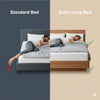Single vs Double Bed Headboards: Choosing the Perfect Size for Your Space
- by Giorgi Gogidze

When designing your bedroom, the headboard serves as both a functional and aesthetic centerpiece. Beyond simply marking where your bed begins, a well-chosen headboard can transform the entire feel of your space, provide comfort for reading or watching TV, and serve as a stunning focal point. However, selecting the right size headboard requires careful consideration of your bed dimensions, room layout, and personal style preferences.
[toc]
Understanding Headboard Sizing Basics
The fundamental rule of headboard sizing is simple: your headboard should complement your mattress size while enhancing your room's proportions. Single bed headboards typically measure 36-39 inches wide, designed to pair with twin or single mattresses. Double bed headboards, measuring 54-57 inches wide, are crafted for full or double mattresses. However, the decision isn't always straightforward, as room size, ceiling height, and design goals all play crucial roles.
Single Bed Headboards: Maximizing Smaller Spaces
Single bed headboards excel in compact bedrooms, guest rooms, and children's spaces where every square foot matters. Their narrower profile creates the illusion of more floor space while still providing that essential design anchor. In studio apartments or smaller bedrooms, a single headboard prevents the space from feeling overwhelmed by oversized furniture.
The beauty of single headboards lies in their versatility. They work exceptionally well in rooms with multiple beds, such as shared children's bedrooms or guest rooms with twin beds. You can create symmetrical designs with matching headboards or mix different styles for an eclectic, personalized look. Additionally, single headboards often come with more affordable price points, making them ideal for budget-conscious decorators or those furnishing multiple rooms.
For renters or frequent movers, single headboards offer practical advantages. They're easier to transport, require less wall space, and adapt more readily to different room configurations. This flexibility becomes particularly valuable when transitioning between apartments or homes with varying bedroom sizes.
Double Bed Headboards: Creating Bold Statement Pieces
Double bed headboards command attention and create dramatic focal points in medium to large bedrooms. Their increased width provides better proportional balance with full-size mattresses and can make spacious rooms feel more intimate and well-designed. The larger surface area also offers more opportunities for intricate designs, upholstery details, or built-in features like shelving or lighting.
In master bedrooms or primary sleeping spaces, double headboards contribute to that luxurious, hotel-like atmosphere many homeowners desire. They provide excellent support for sitting up in bed, whether you're reading, working on a laptop, or enjoying breakfast in bed. The wider profile also offers better sound absorption, which can improve sleep quality in busy households.
Double headboards work particularly well in rooms with high ceilings, where single headboards might appear lost or disproportionate. They help fill vertical space effectively and can be paired with tall bedside tables and substantial lighting fixtures to create a cohesive, grand design scheme.
Room Proportions and Spatial Considerations
Your room's dimensions should heavily influence your headboard choice. In bedrooms smaller than 100 square feet, single headboards typically provide better spatial harmony, even when paired with double beds. The key is maintaining adequate walking space around the bed while ensuring the headboard doesn't overwhelm the room's scale.
Consider the relationship between your headboard and other bedroom furniture. In rooms with large dressers, armoires, or sitting areas, a double headboard can hold its own among substantial furniture pieces. Conversely, minimalist bedrooms with sleek, modern furniture often benefit from the clean lines and understated presence of single headboards.
Wall space behind your bed also matters significantly. Measure not just the width available, but consider how the headboard will interact with windows, electrical outlets, and architectural features like crown molding or chair rails. A headboard should have at least 6-8 inches of wall space on each side to avoid appearing cramped.
Style and Design Flexibility
Single headboards offer remarkable design flexibility, particularly for those who enjoy changing their decor frequently. Their smaller scale makes it easier to incorporate bold colors, patterns, or materials without overwhelming the space. You might choose a vibrant velvet single headboard that would feel too intense in a larger size, or experiment with unique shapes and textures.
Double headboards, while requiring more commitment due to their size and cost, offer opportunities for truly spectacular design statements. They can accommodate complex upholstery patterns, intricate carved details, or built-in functionality that single headboards simply cannot support. Consider how your chosen headboard will age with your style preferences and whether its impact will remain appealing over time.
Practical Functionality Considerations
Think beyond aesthetics to consider how you actually use your bed. If you frequently read, work, or watch television while in bed, the wider support surface of a double headboard provides superior comfort and ergonomics. The additional width distributes pressure more evenly and reduces strain on your neck and shoulders during extended sitting periods.
For couples sharing a bed, double headboards eliminate the awkward gap that can occur when two people lean against a narrow single headboard simultaneously. This practical consideration becomes particularly important if your bedroom serves as a multi-functional space for relaxation and activities beyond sleeping.
Budget and Long-term Value
Single headboards typically cost 20-40% less than comparable double headboards, making them attractive for budget-conscious buyers or those furnishing multiple bedrooms. However, consider the long-term value proposition. A high-quality double headboard might serve you well through multiple home moves and design changes, while a single headboard might need replacement if you upgrade to a larger bed or move to a more spacious room.
Factor in installation and potential modification costs as well. Some headboards require professional mounting, and larger pieces may need additional wall reinforcement or electrical work for integrated lighting features.
Making Your Final Decision
Your ideal headboard size depends on balancing practical needs with aesthetic goals. Choose a single headboard if you're working with limited space, budget constraints, or prefer flexibility in your design choices. Opt for a double headboard when you want to create a dramatic focal point, have ample room space, or prioritize maximum comfort for in-bed activities.
Remember that headboards are investments in your daily comfort and your home's overall design. Take time to measure carefully, consider your long-term needs, and choose a size that will enhance both your sleep experience and your bedroom's visual appeal for years to come.
The perfect headboard size ultimately supports both your practical needs and design vision, creating a bedroom space that feels both functional and beautifully proportioned to your unique living situation.




